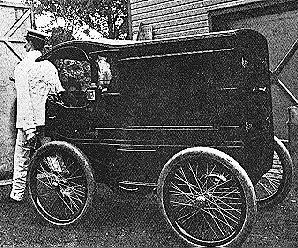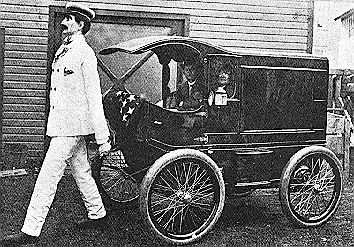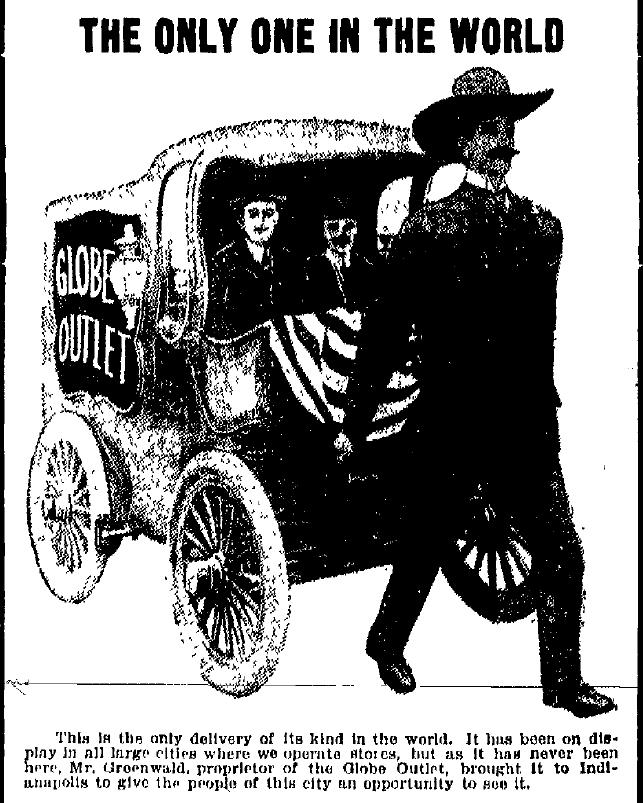The Louis Philip Perew "Electric Man", due to an often referenced article by "The Strand Magazine", is dated as 1900. Further, due to a popular site that mis-represents early walking machines and steam men, it is also referred to as "Automatic Man". I elect to present the full story as I understand it to be. To spoil the fun and illusion, I will at the outset identify this machine as a fake i.e. is does not actually pull the wagon behind it, but, in fact, the powered wagon drives and pushes the "electric man". Due to a clever design, the feet appear to be touching the ground most of the time, adding to the illusion.
1894 – Louis Philip Perew’s “Electric Man”
(patent with Joseph A. Dischinger Pat # 949287)
Name: Louis M Perew Birth: Nov 1871 – Canada Arrival: 1878 Residence: 1900 – Tonawanda Village (Part), Erie, New York, Tonawanda, Erie, New York
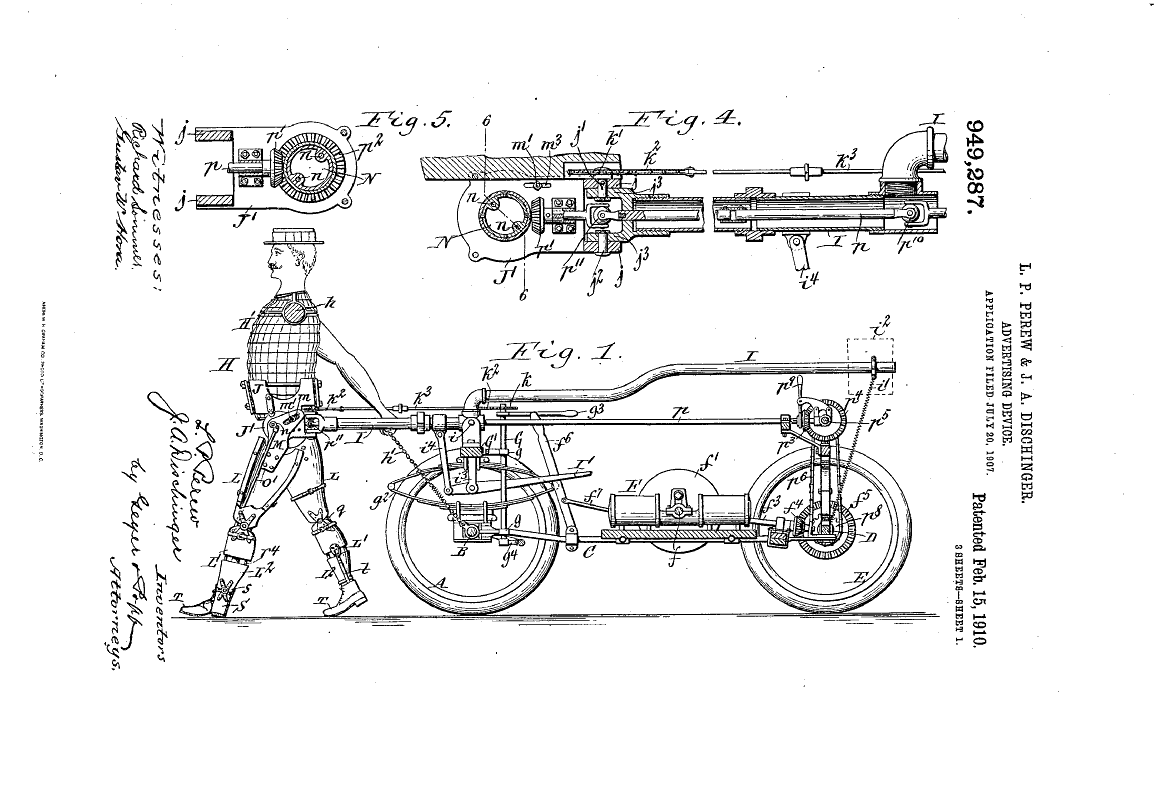
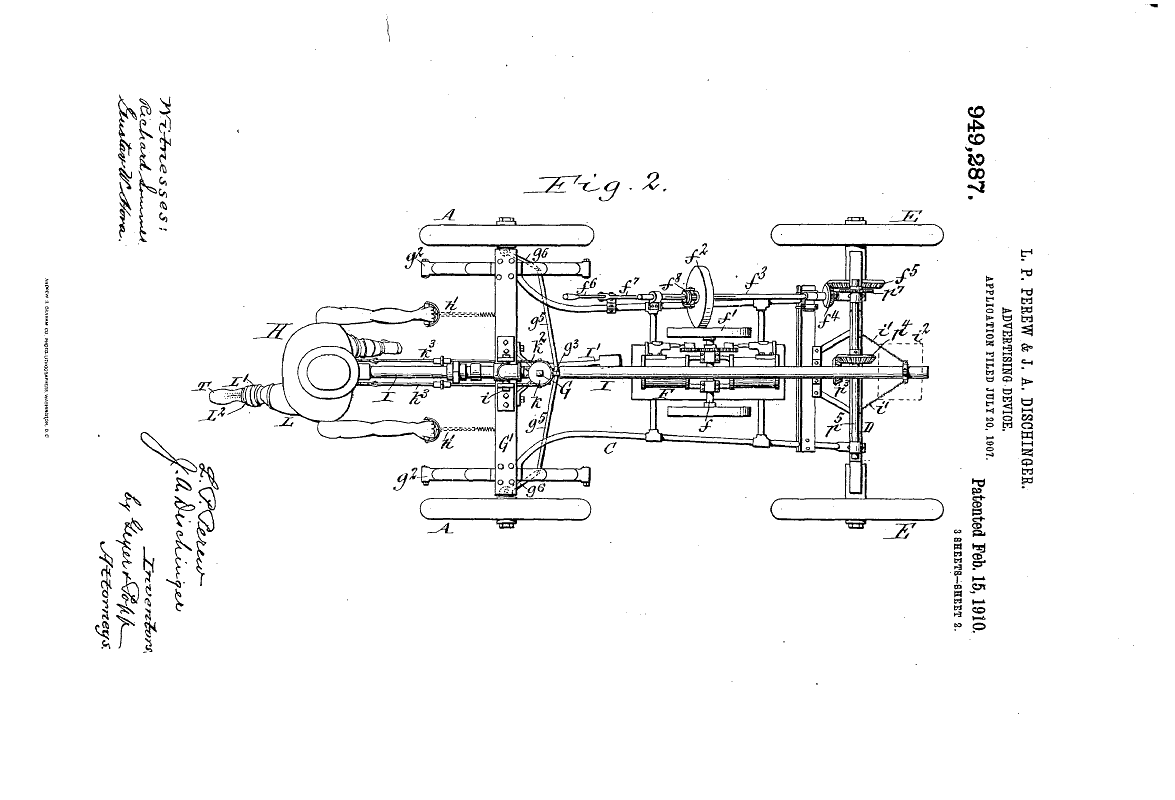
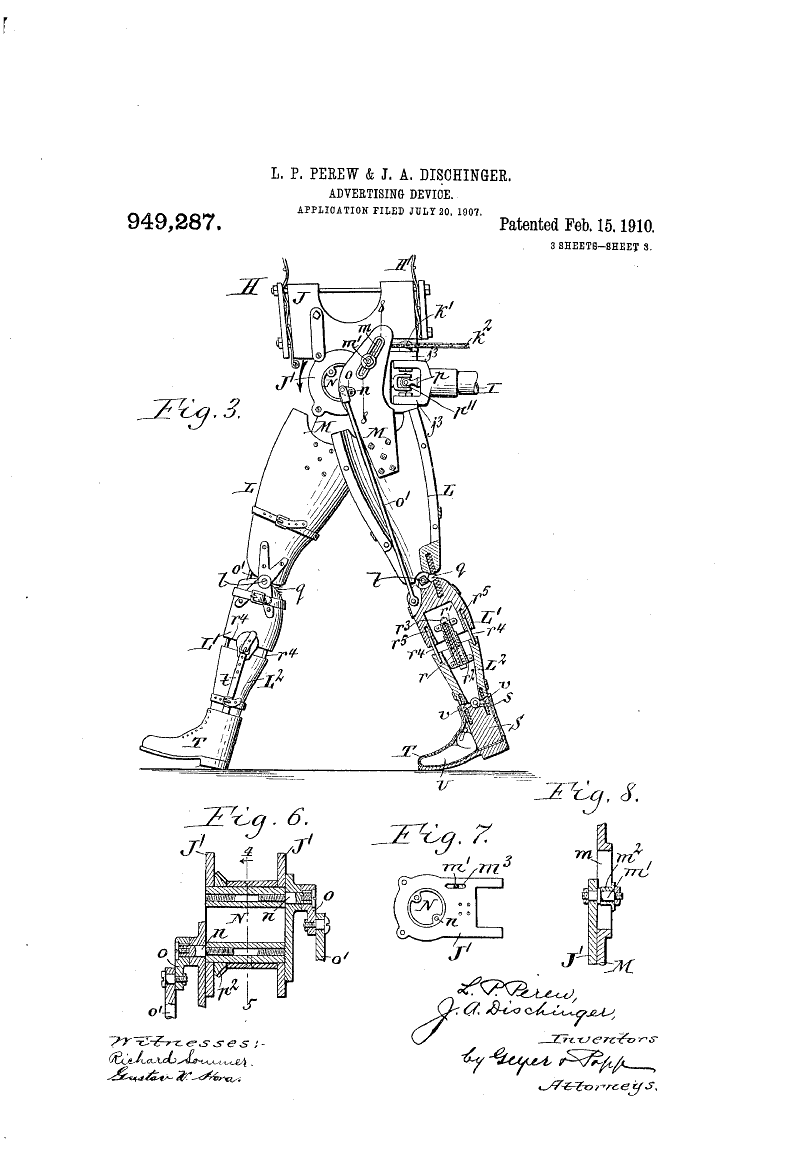
Tonawanda , western New York – a small town near Niagara Falls.
Perew worked at the Herschel Carousel establishment, and his first patent was for a Roundabout (merry-go-round) that was steam-driven and incorporated a stage in the centre for variety performances. (See US Patent # 499,800)
Back in 1891 [*Strand states 1891, Oskosh1900 states 1895 but I think this later date is wrong], Perew constructed a small working model embodying his ideas. It was a little figure of wood, about 2ft 6in to 3 ft. in height, and attached to a small cart. When the cart was pushed along by hand the legs of the automaton were set in motion, but the mechanism was far from perfect.
Perew decided to build another, life-sized figure, and attracted home-town capitalists to invest in this enlargened version.
This next version, referred to as “The Electric Man”, was publically announced in 1895. It was reported, “ it seemed to exhibit more power than flexibility. All that he is good for at present is to pull a cart about the Streets.”
The model is seven feet high and clothed in a military uniform. It had no reversing mechanism, making it unsuitable for parading backward and forward in front of a store. It was also designed to incorporate a phonograph and supplied with wax cylinders containing the appropriate spiel.
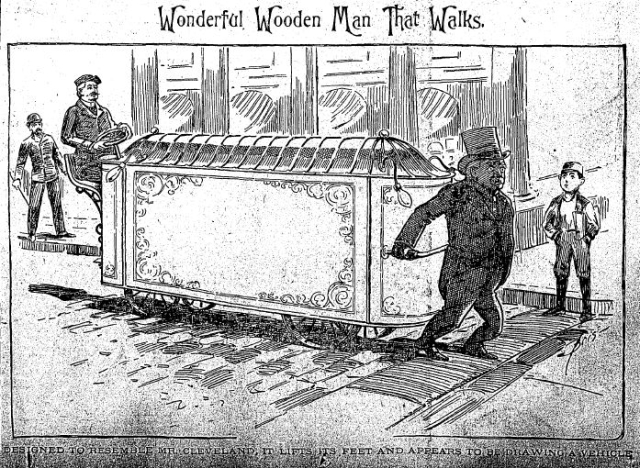
This second version was attached to a ponderous carriage in which sat two men, who propelled the vehicle by hand power. The automaton walked, but its knee action was jerky.
After numerous efforts to improve the mechanism, Perew gave up for a time, and his financial backers backed out.
In the winter of 1899 Charles A. Thomas of nearby Buffalo came to Perew and offered to secure capital to back him if he would go to work on the automaton idea again. Perew accepted the offer of Mr. Thomas, and the result was that a stock company was created by a syndicate of western New York capitalists, which includes ex-Representative In Congress Rowland B. Mahany of the Thirty-second New York district. They were incorporated under the name of the United States Automical company [ Another article refers to the United States Automaton company]. They expected to make a fortune out of their remarkable walking giant.
As reported in the press at the time, the automaton appeared exceedingly life-like. Were it not for the abnormal height of 7ft 5in – one would almost mistake the figure for that of an actual man. The face had a sort of woodenness about it. The figure was clothed in a huge suit of white duck [heavy cotton, canvas-like material], and wore a cap made of the same material.
It wore large size 13 shoes, and within the shoe the feet are composed of inflated rubber offering compliance with an irregular surface and walking action.
The bronzed hands were more true to life than any other portion of the figure. These hands grasped metal rings, attached to chains, which in turn were connected with the small wagon which the figure “draws”.
Seen in a position of rest, the figure of the automaton did not strike one as being especially life-like. But when this figure was put in motion by means of its interior mechanism the resemblance to a living man was very striking.
Just prior to its first public outing, Perew put the figure through its "paces". The exhibition took place in a large drill hall in Tonawanda. At first the automaton took a slightly undecided step, advancing with the right foot and bringing it down with a little jolt. This movement was accompanied by a slight whirring noise, as if clockwork had been set in motion. With the right foot planted in advance, the figure then raised itself slightly on the ball of the foot; drew up the left foot, advanced it, and placed it down with somewhat more easy motion than the first movement. Then the figure began to walk. The big automaton walked away with a steady, swinging gait resembling that of a national guardsman on parade.
“Heel and Toe”, it walked smoothly, and almost noiselessly. The tread was said to be light, firm, and elastic. Twice the figure made the circumference of the hall without stopping. It was controlled by means of an electric battery. The walk was rapid, and at the end of the journey around the hall the step was as resilient as at the beginning. The inventor of the machine-man said it could keep up that pace for an almost unlimited time. But the figure, on this question, spoke for itself. "I am going to walk from New York to San Francisco," it said, in a deep clear voice. Within the chest of the automaton was concealed a phonograph with the appropriate wax cylinder inserted. This phonographic arrangement produced the vocal sounds and one of the cylinders was so arranged that one would think the giant was holding a conversation
with the occupants of the vehicle.
While all the earlier reports said that the giant “draws” the carriage, in reality he does not do so. It became evident by one reporter in September of 1900 when, by a close expert examination of the mechanism of the man and the vehicle, the motive power is actually a gasoline engine concealed under the carriage, [ note that by this time the automaton had changed from an electric motor to a gasoline powered engine], and that power was transmitted to the carriage’s rear wheels . The automaton was actually pushed by the carriage and the power for the walking mechanism was transmitted by a rotating shaft contained within a small ½-in diameter tube connecting the man to the carriage. [see US patent # 949,287 for actual details of operation]
The engine operated machinery in the head, arms, trunk and legs of the automaton, causing him to stride out rapidly, vigorously and naturally. Motion of the jaws and mouth added to the illusion. This motion appeared to be powered by clockwork, as did the orbitally moving eyes and tongue. These were controlled by the driver in the carriage.
He could walk forward and backward, to the right or the left, with a step exactly like that of a human being. His heavy polished shoes would thump the floor. Universal Joints made it easy to control his course and he would dash around a corner with the carriage “in tow” very naturally.
The carriage was a handsome and comfortable vehicle. It was painted black and trimmed in red. The supports for the floor of the carriage looked like handsome
polished rods, running from the rear to the forward trucks, but they were in reality a series of pipes through which water was pumped to keep cool the gasoline supply, which was carried in a concealed tank. The machinery was so arranged that every action of the giant could be controlled from the carriage, and the steering appeared to be done by turning the big wooden and iron man to right or left at will. Actually the steering was by direct control of the front steering wheels and the automaton was “pushed” into the deirection of travel. The levers were all cunningly concealed, as was all the machinery.
It has been mentioned that the machine can jump. This was a necessary function due to the state of the roads then. In one demonstration a large block of wood was placed in the path of the machine, and when it came to this obstruction it stopped, rolled its eyes in the direction of the obstacle, as if calculating how it could surmount it. It then deliberately raised the right foot, placed it upon the object, and stepped down on the other side. The motion seemed uncannily realistic. In reality, there was a foot lever inside the carriage and when depressed, would raise the man.
When necessary the giant could be detached from the carriage and, together with the vehicle, could be shipped to any desired point. It took only a few minutes to reattach him and start off across country. He was capable of a speed of twenty miles an hour.
Either on a $25,000 wager or just advertising purposes, the United States Automical company was to send the first machine across the continent from New York to San Francisco. It was expected to make record time, and to attract the attention of the entire country. In the carriage, it was reported that Messrs. Fred Michaels and J. A. Dischinger would be seated. [Note that Dischinger is the registered co-inventor with Perew]
Perew claimed that he could make the figure move at the rate of twenty miles an hour, or 480 miles for the day's run. This twenty-mile-an-hour rate of speed allows for three stoppages out of each day, an hour's time being allowed for each stop. A fast train between New York and San Francisco accomplishes the 3,250 miles between the two points in 124 & 1/2 hours. The “automatic man”, travelling the same distance, would take 162 & 1/2 hours – or only thirty-eight hours slower than the then fastest train.
It was the intent of the inventor and his investors to produce many advertising automatons. Records have not yet been discovered to see how many, if more than the one version was built.
In 1914, “Big Chris” was the star attraction for the Globe Outlet clothing store of Indianapolis, USA. Either “Big Chris” was one of the production models, or it was the surviving 1900 gasoline-engine model as he was advertised as the “only one in the world”. Since that date, there are no further press reports of “Big Chris” or the “Electric Man”.
In 1927 (filed in 1924), Perew did produce a toy version of his Walking automaton, though this time a carriage-pushing man (again, the carriage propelling the man, not the other way around) . See US patent # 1,6134,08.
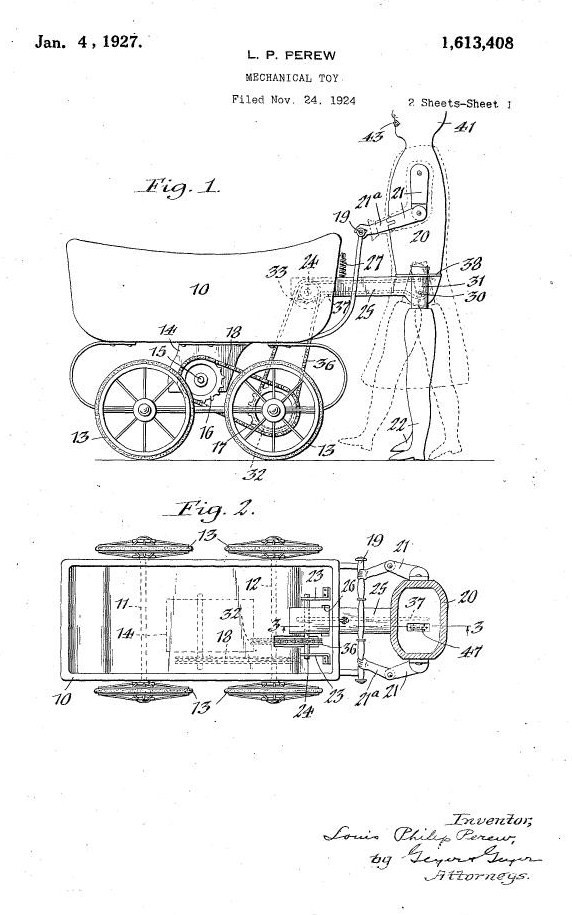
Note: Due to Perew’s “Electric Man” aka the “Automatic Man” story being published on Big Red Hair’s webpage, he has been incorrectly relegated as a fiction being aligned with the fictitious “Boilerplate”. At the time of writing, Wikipedia still has Perew’s “Electric Man” incorrectly stated as a Tonawandin fiction.
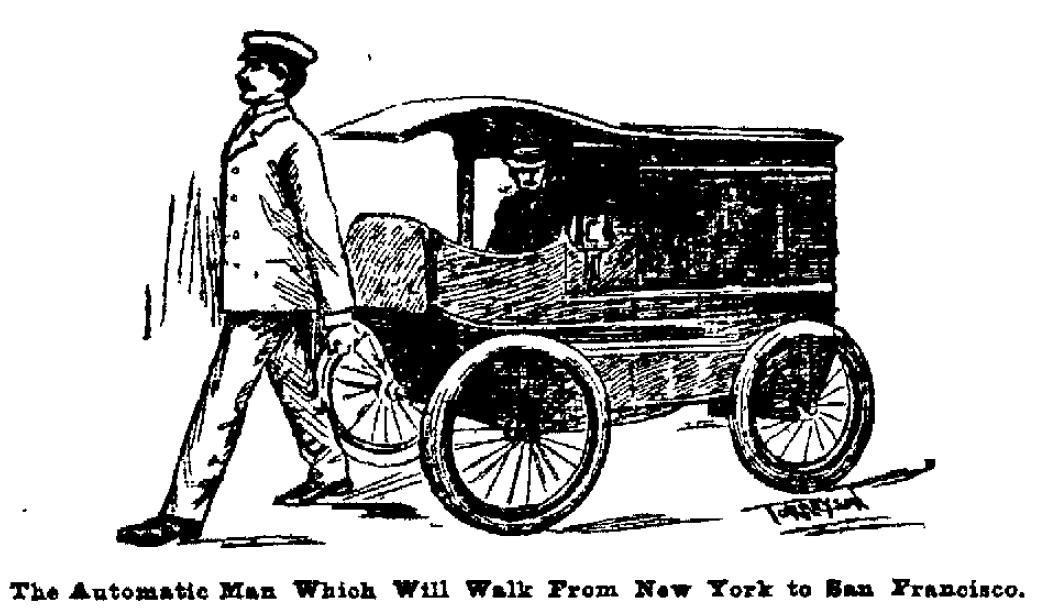
Iowa State Reporter 25 Oct 1894 p2
A FIGURE moving by electricity measuring 6 feet in height and singing songs, has been perambulating the streets of New York. The electric man moves his head, arms and legs as though instinct with life, and can walk about 13 miles an hour. The figure is attired in evening dress, with a white necktie, the boots are made of iron with soles of very strong and durable leather. The motion of the arms and legs is performed with the greatest regularity, so that the automaton never loses its balance. When singing its mouth opens and closes as occasion requires.
[possibly Perew's 1st version of his electric man . A phonograph was used as his 'voice'. Tonawanda is in New York. No other "electric man" known for this period]
——————————————–
The following article titled "An Electric Man" by W.B. Northrop was published in The Strand Magazine of London, England. Nov 1900 p586-590
American ingenuity is ever striving for startling effects. It is never satisfied. Ordinary achievements seem beneath its attention. It looks beyond, even if the object of its aim be more or less fantastic.
One of the latest freaks of mechanical skill is the construction, by Louis Philip Perew, of Tonawanda, New York – a small town near Niagara Falls – of a gigantic man. Perew, with all the ardour of a modern Frankenstein, has endeavoured to make his man as life like in appearance as possible. Not only is its outward form a close model of a human being, but within it have been secreted mechanical devices which endow the automaton with weird properties, making it even more nearly resemble an intelligent being.
Nikola Tesla recently constructed a machine called the Telaumaton. It did everything but think. Perew has out-Teslaed Tesla. The great electrician's device bore no resemblance to a human being. It was devoid of the human body as a medium through which to operate.
The Frankenstein of Tonawanda has brought into existence a thing of wood, rubber, and metal, which walks, talks, runs, jumps, rolls its eyes – imitating to a nicety almost every action of the original on which it is founded. All that is lacking is the essential spirit – the Promethean fire, as it were – which would enable one to say to the automatic creature, "Thou art a man".
For several years Mr. Perew has been engaged in inventing various appliances. He is more or less skilled in all branches of mechanical work, and his mind teems with ideas wich are often astonishing as they are original.
On first sight of the automaton one is impressed with the exceedingly life-like appearance of the novel object. Were it not for the abnormal height – 7ft 5in – one would almost mistake the figure for that of an actual man. It is true there is a sort of woodenness about the face that betrays its nature; but, for that matter, many human faces are "wooden" in expression. The figure is clothed in a huge suit of white duck, and in its coat – a rather fantastic decoration, to my judgement – is a pretty boutoniere. On the man’s enormous head is a cap of Brobdingnagian proportions. Never before was so large a hat turned out by any manufacturer. It is made of white duck, like the suit.
The feet of the machine-man are of gigantic mould. It wears a shoe the size of which is 13. Within the shoe the feet are composed of inflated rubber.
One of the most striking objects about the man are the hands. They are more true to life than any other portion of the figure. The skin effect is marvellous. The hands are bronzed, as if from exposure and hard work, and the delusion is still farther carried out in many minute particulars. Ordinarily, these hands are shown grasping metal rings, attached to chains, which in turn are connected with the small wagon which the figure draws.
Seen in a position of rest, the figure of the automaton does not strike one as being especially life-like. It lacks the muscular repose of the human body.
But when this figure is put in motion by means of its interior mechanism the resemblance to a living man is very striking.
At request Mr. Perew, the inventor, put the figure through its "paces". The exhibition took place in a large hall in Tonawanda. At first the automaton took a slightly undecided step, advancing with the right foot and bringing it down with a little jolt. This movement was accompanied by a slight whirring noise, as if clockwork had been set in motion. With the right foot planted in advance, the figure then raised itself slightly on the ball of the foot; drew up the left foot, advanced it, and placed it down with somewhat more easy motion than the first movement. Then the figure began to walk.
It walked smoothly, and almost noiselessly. The tread was light, firm, and elastic. Twice the figure made the circumference of the hall without stopping. It was controlled by means of an electric battery. The walk was rapid, and at the end of the journey around the hall the step was as resilient as at the beginning. The inventor of the machine-man said it could keep up that pace for an almost unlimited time. But the figure, on this question, spoke for itself. "I am going to walk from New York to San Francisco," it said, in a deep clear voice. The voice sounded as if it proceeded from a megaphone. Within the bosom of the automaton is concealed a talking machine. Perew's man may be taught to say anything.
As far back as 1891 the inventor of the present automatic man constructed a small working model embodying his ideas. It was a little figure of wood. It was 2&1/2 ft. in height, and attached to a small cart. The little figure drew the wagon about, and many persons wondered at the ingenuity of the man who could invent so novel a machine. Then the inventor conceived the idea of building a still more remarkable figure. If the small model could be made to work, there was no reason why a life-sized figure would not do equally as well as, or even better than, the smaller machine.
Capitalists in Mr. Perew’s own town became convinced that money could be made out of the automatic figure, if it were constructed on an enlarged scale.
At first imagination rather ran riot as to the possible uses to which the machine-man could be put. It could be made to carry loads in places inaccessible to ordinary vehicles with wheels; it could ascend heights impossible to men. It could walk distances which would weary the most skilful pedestrian; it could be made to do a thousand and one things which men of flesh and blood would shrink from.
Perhaps, in time, imagination suggested, it could become a fighting appliance, carrying death and destruction in its machinery. Guided by electrical wires, why should not a man of this kind be sent out as a carriage for a species of rapid-fire gun? Protected by bullet-proof clothing, it would prove a fearless and dangerous foe. If the body could be made to move at certain angles the aim of the automaton could be directed by an operator concealed and protected from harm. Why not?
In cogitating over all these possibilities Mr. Perew saw for his automaton a brilliant future. The difficulty now was to convince others that his ideas could be made to work..
With his wooden model he applied, to one capitalist after another, endeavouring to raise sufficient money to carry out his ideas in a practical manner. At length he succeeded in interesting Mr. Charles A. Thomas, a moneyed man who resided in Cleveland, Ohio. Mr. Thomas purchased an interest in the patent rights, which had been secured by Perew, and, before long, a regular company was formed. It was known as the United States Automaton Company, the main offices of which were situated in Buffalo, New York State.
It is understood that a great deal more money is behind the enterprise. It is even said that the company will soon be manufacturing automatons for shipment to all parts of the world.
The first shipment outside the United States will be made to England. Perhaps, before many months have passed, Londoners may awaken some fine morning to see a man of Titan build hurrying through the streets drawing an omnibus. It might not be even amiss to suggest, in advance, a title for the 'bus line – how would the ‘Frankenstein Express’ answer?
Can such a motive-power be operated cheaper than an ordinary automobile? Is it better than horseflesh? Would it be allowed on the city streets? Would it not endanger life from causing horses to run away? Would it not prove too great a shock to children and nervous women? These are questions which can only be answered after actual experimentation.
The building of the great automaton has been done in much secrecy. Mr. Perew did not wish his work to be talked about before it was well nigh completion. He thought people might conclude that he was a crank without practical aim. Now, however, that the automaton is a finished work – satisfactory in every way to the inventor and to those associated with him – he has permitted inspection.
The boast of the strange creation of the inventor's mind is said to be a perfectly reasonable one. It has been announced by the United States Automaton Company that, before long, they intend starting the figure on a walk across the Continent. It will draw behind it a light wagon, in which will be seated Messrs. Fred Michaels and J. A. Deschinger.
The inventor claims that he can make the figure move at the rate of twenty miles an hour, or 480 miles for the day's run. This twenty-mile-an-hour rate of speed allows for three stoppages out of each day, an hour's time being allowed for each stop. A fast train between New York and San Francisco accomplishes the 3,250 miles between the two points in 124 & 1/2 hours. The automatic man, travelling the same distance, would take 162 & 1/2 hours – or only thirty-eight hours slower than the fastest train. Not a bad record for a pedestrian, by the way!
When the automaton had been made to walk around the hall in which it is kept the inventor caused it to do some feats which, to an ordinary onlooker, seemed impossible for the performance of an insensate thing. A large block of wood was placed in the path of the machine, and when it came to this obstruction it stopped, rolled its eyes in the direction of the obstacle, as if calculating how it could surmount it. It then deliberately raised the right foot, placed it upon the object, and stepped down on the other side. The motion seemed uncannily realistic. You almost feel like shrinking from before those rolling eyes. The visionless orbs are operated by means of clock-work situated within the head.
Inventor Perew has closely concealed from view the interior mechanism of his automatic man. The skin of the man, however, is made of aluminium, this metal being chosen on account of its lightness. The man is supported within by a strong steel frame-work, and the interior doubtless contains an electric storage battery. In the small of the back is a small metal tube about one-half inch in diameter. Into this tube, which connects with the operator seated in the automobile wagon behind the figure, runs the current which guides the figure through its various movements. No connection between the figure and the automobile exists – other than the chains already mentioned and the little tube. The power in the figure is supplied within itself.
Were the inventor of the strange mechanical man a crank, and all his ideas only on paper, little attention might be paid to his fantastic notions. But Mr. Perew seems eminently practical. Besides, he has associated with him in his enterprise a number of level-headed business men who would not spend a penny unless they were able to see the money coming back to them at no distant time, and with increased interest.
The turning out of automatons of the same build and construction as the first model will soon be in progress. Perew has already realized a decided triumph, so far as mechanical detail goes. The utility of the project now remains to be demonstrated.
New York Times 04 Aug 1895 p23
Note: Newspaper archive incorrectly has this article as 1891, but it should be 1895.
The electric man, of which startling descriptions have lately gone the rounds, is at last a reality. A very capable specimen has been turned out by a merry-go-round factory at Tonawanda. The electric man, however, seems, so far, to exhibit more power than flexibility. All that he is good for at present is to pull a cart about the streets, and this he is doing in Tonawanda, to the delight of the populace, and, incidentally, it is presumed, to the advantage of a certain soap of which the sides of the cart bear exultant signs. The model is seven feet in height and is clothed in a military uniform. It walks away with the cart in brilliant style. The field of the electric man will doubtless widen, but for some time it will be restricted to the duties of the sandwich man and the campaign speaker. As a sandwich man, his stalwart proportions would be a distinct recommendation, and it is proposed to supply him with a reversing adjustment for the regulation of his backward and forward march in front or a store. But as a political campaigner he ought to be a bright, particular star. A phonograph can be comfortably fitted into his diaphragm and supplied with cylinders containing the appropriate speeches of the leaders of the party. Any number or these automatic orators can be sent out to do the rough-and-tumble work of his campaign, and, being "heckle proof," it is easy to see what a godsend they would be to a candidate of modest and retiring disposition.
1891
Tonawanda
Herschel Carrousel (sic) now ships one new carousel every day.** Inventor Philip Perew works on a steam-driven carousel incorporating a stage in the center for variety performances.
Patent # 499800
Example of how brh is creating confusion over what's fact and what's fiction :
Tonawanda is mentioned as the home of the fictional character Louis Philip Perew (see here), in the alternate history world created by artist and author couple Paul Guinan and Anina Bennett. In this history, created for the graphic novels Boilerplate and Femopolis, Perew creates an electromechanical man, called the 'Automatic Man', in the late 19th century.[11]
Oshkosh Daily Northwestern 15 Sep 1900 p4
A Wonderful Mechanical Man.
A New York Inventor Has Completed an Automatic Giant Who Will
Walk Across the Continent Drawing a Carriage.A wonderful invention has just been completed by Captain Louis Philip Perew of North Tonawanda, N. Y.. and the model is now receiving its finishing touches and will be publicly exhibited soon. It is a giant automaton which walks, talks, smokes cigars, protrudes its tongue and performs various tricks. In addition to dragging a handsome carriage behind it.
A syndicate of western New York capitalists, which includes ex-Representative In Congress Rowland B. Mahany of the Thirty-second New York district, are backing the inventor, and they have been incorporated under the name of the United States Automical company. They expect to make a fortune out of the remarkable walking giant.
While it is said that the giant draws the carriage, he really does not do so, but this fact could not be discovered except by a close export examination of the mechanism of the man and the vehicle.
The motive power is a gasoline engine, but its whereabouts cannot be detected by any casual observer or even by a close inspection, unless an expert machinist is called in to make an examination.
The engine operates machinery in the head, arms, trunk and legs of the automaton, causing him to stride out rapidly, vigorously and naturally. He Is a typical "heel and toe" walker, and his step is dignified and proud. His bearing is like that of a military officer.
All his motions are humanlike. The face is strikingly human in appearance, and the motion of the jaws and the sound of a voice proceeding from his mouth add to the illusion. A phonographic arrangement produces the vocal sounds and it is so arranged that one would think the giant was holding a conversation with the occupants of the vehicle.
The wooden and iron man is seven feet five inches in height. His movements are easy, graceful and natural, and he will walk forward and backward, to the right or the left, with a step exactly like that of a human being. His heavy polished boots thump the floor with a sound like that made by a large man who has been stirred to sudden activity. Universal Joints make it easy to control his course and he will dash around a corner with the carriage in tow very naturally.
The carriage is a handsome and comfortable vehicle. It is painted black and trimmed in red. The supports for the floor of the carriage look like handsome polished rods, running from the rear to the forward trucks, but they are in reality a series of pipes through which water is pumped to keep cool the gasoline supply, which is carried in a concealed tank.
The machinery is so arranged that every action of the giant can be controlled from the carriage, and the steering is done by turning the big wooden man to right or left at will. The levers are all cunningly concealed, as is all the machinery.
When necessary the giant can be detached from the carriage and, together with the vehicle, can be shipped to any desired point. It is but the work of a few minutes to reattach him and start off across country. He is capable of a speed of twenty-one miles an hour.
—
It is the purpose of the United States Automical company to send the first machine across the continent from New York to San Francisco. It is expected to make record time, and to attract the attention of the entire country.
The finishing touches will be completed in the course of a few days, and it will be brought out for a public exhibition. A trip through the principal streets of this city and Buffalo will be made, and the event will be celebrated by a banquet in the evening.
The inventor, Captain Perew, has been working on this idea for nearly ten years.
He is about fifty years old and has travelled extensively on this continent and in South America.
In 1895 he made the first model of his walking automaton. [If he has been working on it for 10 years, that makes it around 1890. The Strand mentions 1891, and the first full-scale version was built in 1895. I think this date should read 1891, not 1895. RH] It was a wooden figure
about three feet in height attached to a small cart. When the cart was pushed along by hand the legs of the automaton were set in motion, but the mechanism was far from perfect. The inventor's effort attracted attention, however, and a number of local capitalists formed a stock company for the purpose of pushing the enterprise.
———-
Another automaton, larger and better put together than the first model, was constructed. It was attached to a ponderous carriage in which sat two men, who propelled the vehicle by hand power. The automaton walked, but its knee action was jerky. After numerous efforts to improve the mechanism, Perew gave up for a time, and his financial backers backed out. In the fall of 1899 Charles A. Thomas of Buffalo came to Perew and offered to secure capital to back him if he would go to work on the automaton idea again. Perew accepted the offer of Mr. Thomas, and the result was that a stock company was organized and the present remarkable automaton produced after months of labor.
A reporter was invited to see the great work. Gracefully, naturally, with humanlike ease, the big wooden and iron man lifted one of his feet and took a step forward The other foot followed and then the first foot swung forward again. Like a soldier who has received the command "Forward, march!" the big automaton walked away with a steady, swinging gait resembling that of a national guardsman on parade. Down the full length of the large drill hall it strode. Reaching the further end of the hall, it gracefully turned and started back again, with the carriage rolling after it. This was repeated four times.—New York Journal.
1914 – BIG CHRIS

Suburbanite Economist 10 Apr 1914
ENGLEWOOD THEATER
At the Englewood theater, Morris Wainstock's show, "The Rector Girls," "Big Chris," the $20,000 electrical wonder and New Style Tango night. Big features. "Big Chris," the $20,000 electrical-mechanical man, drawing a large automobile, will parade, the streets of the South side for a week, beginning Thursday, April 9, to advertise the popular Englewood theater and "The Recto-Girls" burlesque show. "Big Chris" is a marvel of invention.
Fully attired in man's clothing and standing eight feet high, he will draw the motor car through the streets. By a press of one of several buttons, this "man" can be made to accomplish almost any movement. In fact he can do everything but talk.
Don't miss him. If he does not pass your house, meet him in front of the Englewood, G3d and Halsted Sts., before each evening show.
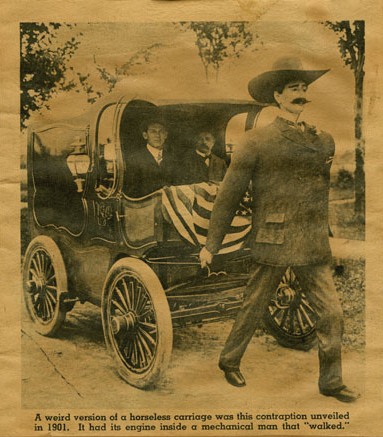
The above image is from here: http://processandpreserve.wordpress.com/2009/09/23/wont-you-step-into-this-cloud-of-steam/

.jpg)
